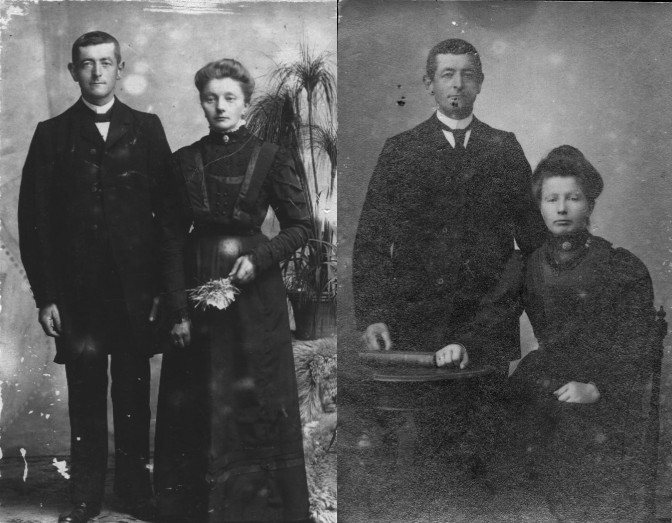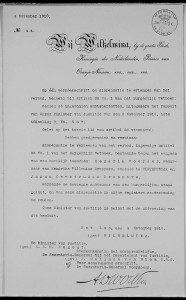When my great-grandparents Hendrik Woordes and Janna Geertruid Droppers wanted to get married in 1910, they were facing a problem. The law did not allow them to marry, since his first wife Hendrika Willemina Droppers had been the sister of Janna Geertruid. Hendrika Willemina had died in childbirth the year before, leaving Hendrik with a motherless infant. When he found her youngest sister willing to marry him and take care of the child, the only way to do that was to apply for a Royal Dispensation.
Applicable law
The civil code, article 88 number 1 stated that the marriage is forbidden:
- between brother-in-law and sister-in-law, whether legitimate or illegitimate and
- between uncle or great-uncle and niece or grand-niece, as well as between aunt or great-aunt and nephew or grand-nephew, whether legitimate or illegitimate.
To our modern eyes, the first impediment seems unreasonable since these people did not share any blood so there was no increased risk for genetic defects. However, since a marriage joins husband and wife in body as well as in spirit, any sister of the wife was also considered to be the sister of the husband. And marrying your sister is and was illegal. Marrying your sister-in-law was considered to be just as incestuous.
A marriage between brother-in-law and sister-in-law remained forbidden until 1939, when the civil code was revised. Until then, such a couple could only marry with Royal Dispensation.
Finding the royal dispensation
When I checked the marriage supplements of my great-grandparents’ marriage, I found a copy of a Royal Decree by Queen Wilhelmina giving them dispensation to marry. It listed the date and number of the Royal Decree (4 November 1910, nr. 44).
Royal Decrees are kept in the archives of the cabinet of the King or Queen at the National Archives in The Hague. In this case, the cabinet of Queen Wilhelmina, who reigned from 1898 until 1948. The archives of her cabinet are available in record group 2.02.14. Call numbers 4551 through 8603 contain the series of laws, Royal Decrees and letters by the cabinet from the period 1898-1944. Call number 5640 contained the documents for 4 – 8 November 1910. The package that arrived when I requested that call number included the original Royal Decree giving my great-grandparents permission to marry.
The information itself was a perfect match with the copy in the marriage supplements, but the original decree had the real signature of Queen Wilhelmina on it, which I think is pretty special.
Did any of your ancestors marry their in-laws? If so, did you check the marriage supplements for a royal dispensation?
![Royal Decree giving permission to Hendrik Woordes and Janna Geertruid Drappers [sic] to be married](https://www.dutchgenealogy.nl/wp-content/uploads/2013/08/KB2-458x672.jpg)
Royal Decree giving dispenation for the marriage of Hendrik Woordes and Janna Geertruid Drappers [sic]
- Winterswijk, Gelderland, Netherlands, Marriage supplements, 1910 nr. 86, Woordes-Droppers, 18 november 1910; “Netherlands, Civil Registration, 1792-1952,” digital images, Familysearch (http://familysearch.org : accessed 27 July 2011); path: Gelderland > Winterswijk > Huwelijksbijlagen [Marriage Supplements] nr. 27 1906-1912
- Queen Wilhelmina, Royal Decree giving dispensation for the marriage of Hendrik Woordes and Janna Geertruida Drappers [sic], 4 November 1910, nr. 44; “Verbaal: wetten, Koninklijke besluiten, kabinetsbrieven 1898-1944 [Papers: laws, Royal Decrees, letters by the cabinet 1898-1944],” call number 5640; “Kabinet der Koningin 1898-1945 [Cabinet of the Queen 1898-1945],” record group 2.02.14; National Archives, The Hague, Netherlands




Wow! That is really an exciting thing to find!
Hi,
I am researching my families history and my Great grand parents are (Great – Great Grandma)Hendrika Bannik and her husband was Hendrikus Bijl, they had 12 children as far as i am told but divorced, My Great grandmother is Willemtien (Bijl) Watson (deceased 2010) these are her parents i am searching for and her husband was Gordon Watson (deceased 2003) , I know they are Dutch also. But i dont know much more than that as i would like to . is this my great great grandfather ???
please help, Thank you
I have found marriage dispensations, I think though issued locally. Not quite such a close degree of consanguinity. Fascinating as they (the online abstracts is all I’ve seen) say first cousins on mother’s side or something.
In the USA in the small Dutch communities, I THINK marriage of a sister-in-law as a second wife was rather common. Obviously there was no royal dispensation in the USA. I know that first cousin marriages were against the law so such couples often married in a different state. Whether that state also had such a law or if the couple neglected to mentioned their blood relationship is not known. But in my grandparents generation, I know of several such cousin marriages that occurred in another state. Also there are many cases of siblings of one family marrying the sibling of another family (adjacent farms). This would be in-laws marrying in-laws. For example two brothers and their sister married two sisters and their brother. All the children were double cousins to each other. It makes interesting family pedigrees.
Intriguing! The in-law inclusion in the definition of incest is an interesting exception, when you compare it with the Old Testament, where the NL got a lot of it’s foundational ideas and laws, including those about incest. Because in Leviticus if your brother died childless, you were actually *required by law* to marry your sister-in-law, get her pregnant, and raise a child in your brother’s name, so that “his line would not perish from the earth.”